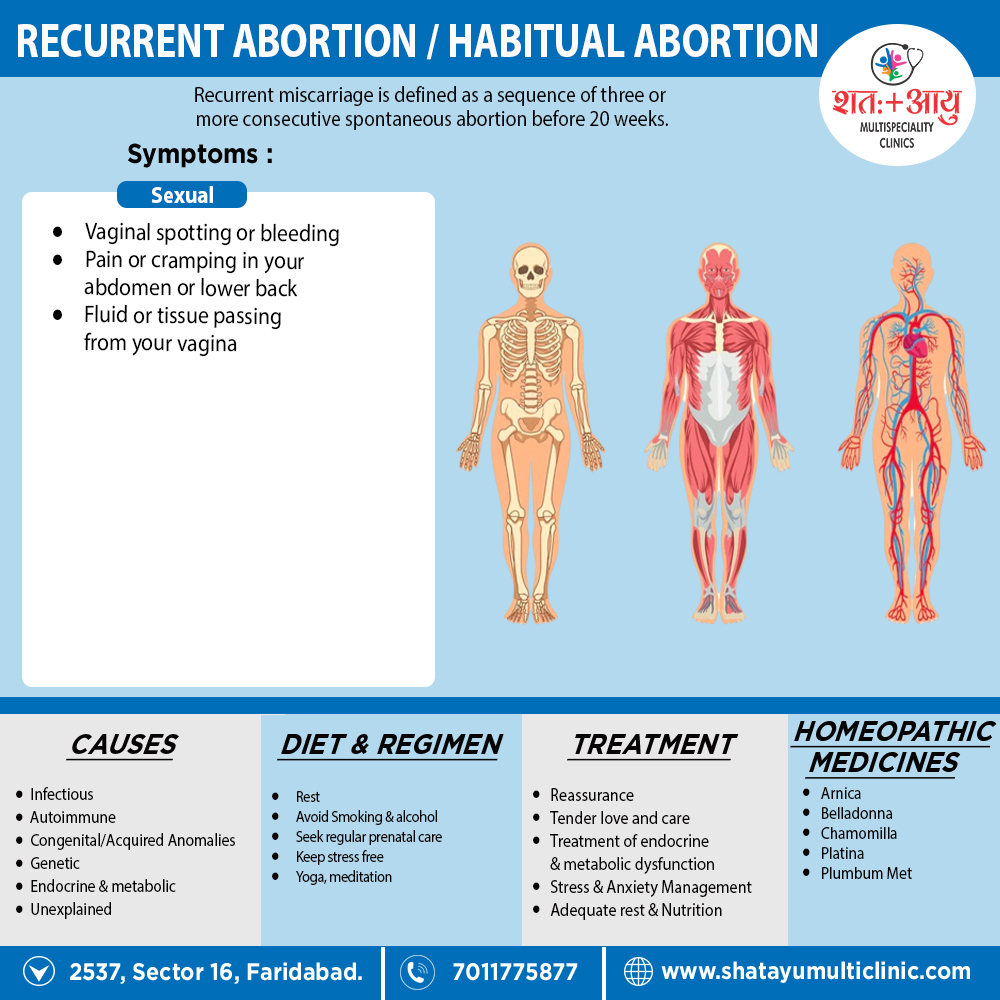Overview of Recurrent abortion
This distressing problem is affecting approximately 1% of all women of reproductive age. The risk increases with each successive abortion reaching over 30% after three consecutive losses.

Recurrent miscarriage is defined as a sequence of three or more consecutive spontaneous abortion before 20 weeks. Some, however, consider two or more as a standard. It may be primary or secondary (having previous viable birth). A woman procuring three consecutive induced abortions is not a habitual abortion.
This distressing problem is affecting approximately 1% of all women of reproductive age. The risk increases with each successive abortion reaching over 30% after three consecutive losses.
The causes of recurrent abortion are complex and most often obscure. More than one factor may operate in a case. Factors may be recurrent or nonrecurrent. There are known specific factors which are responsible for early or late abortion and they are grouped accordingly.
FIRST TRIMESTER ABORTION:
The retentive power of the cervix (internal os) may be impaired functionally and/or anatomically due to the following conditions:
Most miscarriages occur before the 12th week of pregnancy.
Signs and symptoms of a miscarriage might include:
If you have passed fetal tissue from your vagina, place it in a clean container and bring it to your health care provider’s office or the hospital for analysis.
Most women who have vaginal spotting or bleeding in the first trimester go on to have successful pregnancies.
A thorough medical, surgical and obstetric history with meticulous clinical examination should be carried out to find out the possible cause or causes as mentioned previously.
Careful history taking should include—
(1) Blood-glucose (fasting and postprandial), VDRL, thyroid function test, ABO and Rh grouping (partners), toxoplasma antibodies IgG and IgM.
(2) Autoimmune screening—lupus anticoagulant and anticardiolipin antibodies
(3) Serum LH on D2 /D3 of the cycle.
(4) Ultrasonography—to detect congenital malformation of uterus, polycystic ovaries and uterine fibroid.
(5) Hysterosalpingography in the secretory phase to detect—cervical incompetence, uterine synechiae and uterine malformation.
(6) This is supported by hysteroscopy and/or laparoscopy.
(7) Karyotyping (partners).
(8) Endocervical swab to detect chlamydia, mycoplasma and bacterial vaginosis
Homeopathy treats the person as a whole. It means that homeopathic treatment focuses on the patient as a person, as well as his pathological condition. The homeopathic medicines selected after a full individualizing examination and case-analysis.
which includes
A miasmatic tendency (predisposition/susceptibility) also often taken into account for the treatment of chronic conditions.
A homeopathy doctor tries to treat more than just the presenting symptoms. The focus is usually on what caused the disease condition? Why ‘this patient’ is sick ‘this way’?.
The disease diagnosis is important but in homeopathy, the cause of disease not just probed to the level of bacteria and viruses. Other factors like mental, emotional and physical stress that could predispose a person to illness also looked for. No a days, even modern medicine also considers a large number of diseases as psychosomatic. The correct homeopathy remedy tries to correct this disease predisposition.
The focus is not on curing the disease but to cure the person who is sick, to restore the health. If a disease pathology not very advanced, homeopathy remedies do give a hope for cure but even in incurable cases, the quality of life can greatly improved with homeopathic medicines.
The homeopathic remedies (medicines) given below indicate the therapeutic affinity but this is not a complete and definite guide to the homeopathy treatment of this condition. The symptoms listed against each homeopathic remedy may not be directly related to this disease because in homeopathy general symptoms and constitutional indications also taken into account for selecting a remedy.
Recurrent miscarriage is defined as a sequence of three or more consecutive spontaneous abortion before 20 weeks.
References